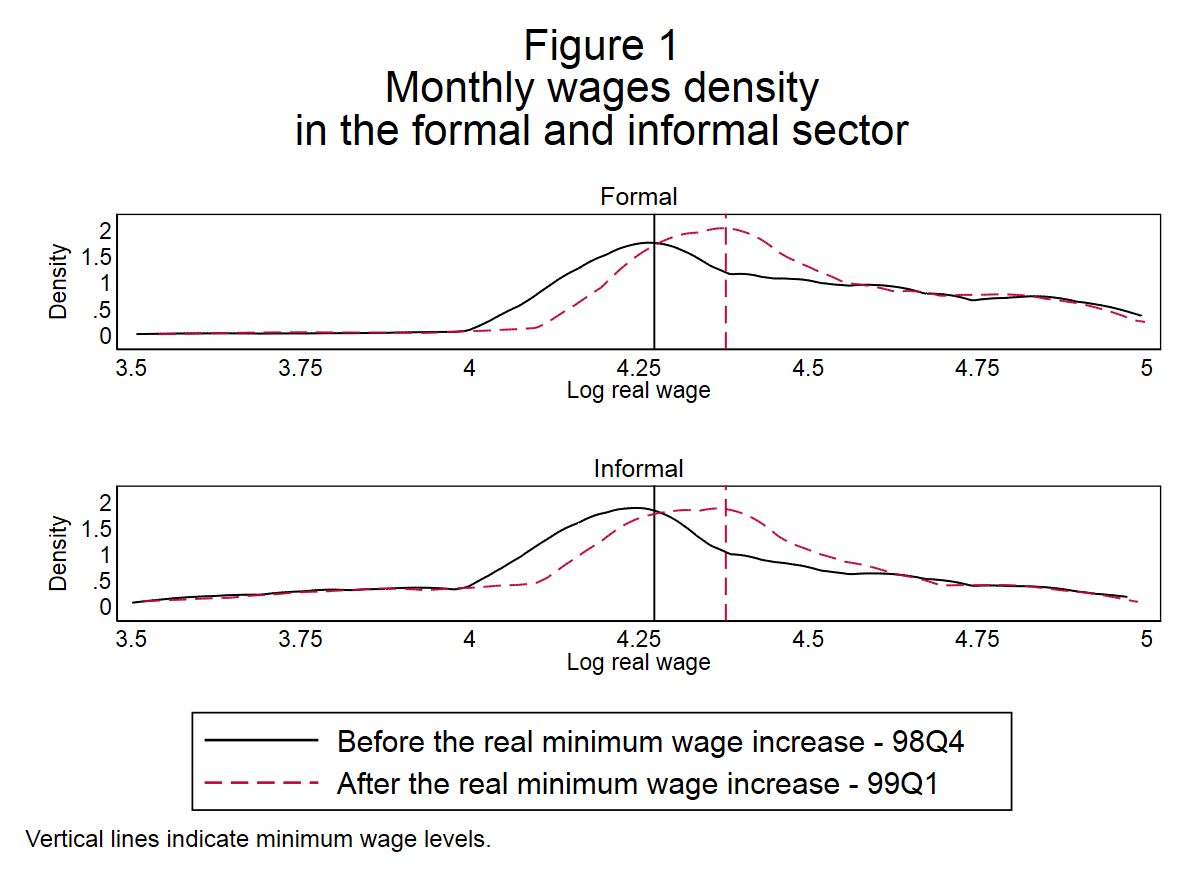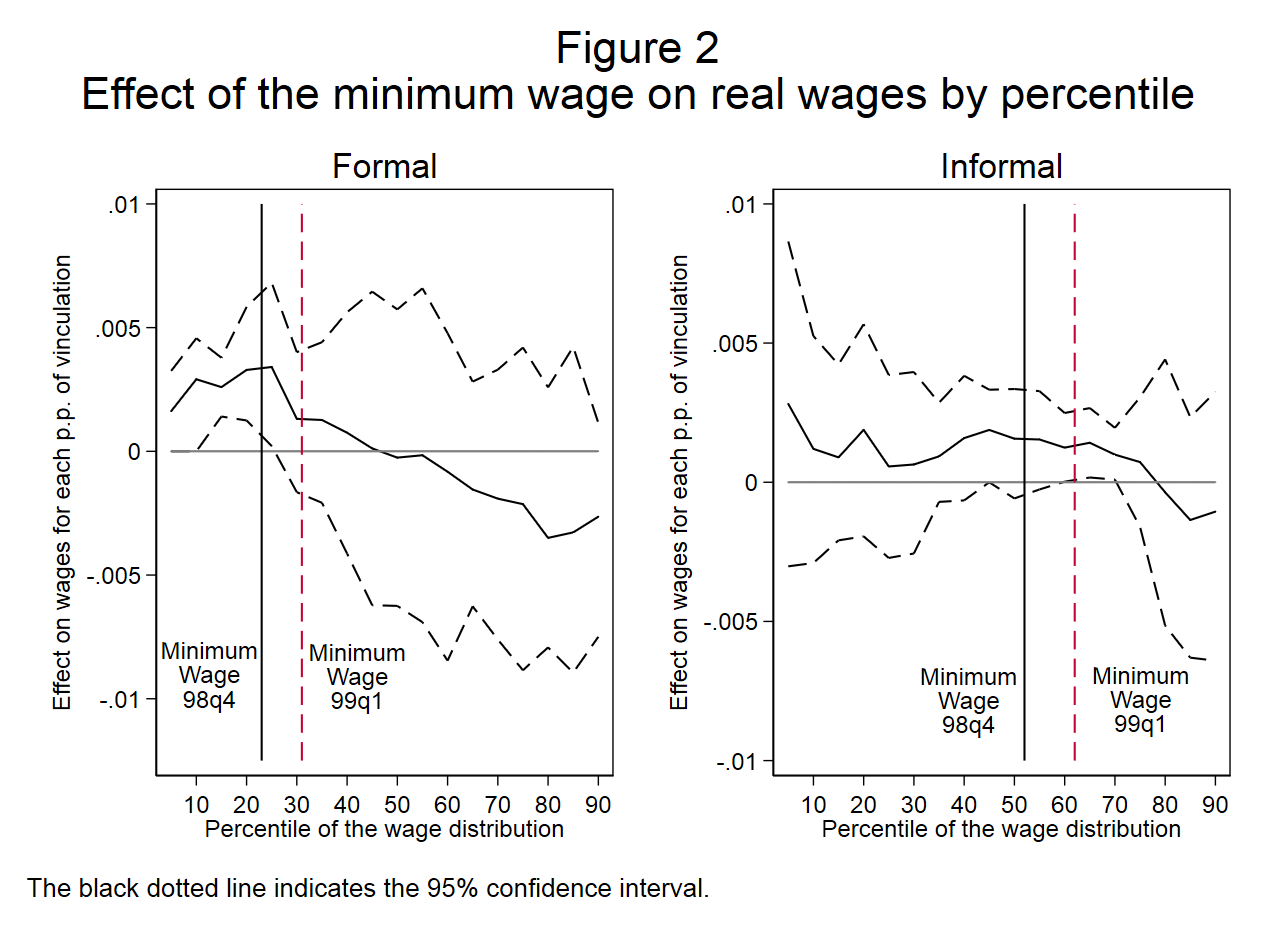The Effects of a Real Minimum Wage Increase in the Formal and Informal Sectors
Published:
The minimum wage is a typical policy in developed and developing countries. Most of the literature about the impact of the minimum wage focuses on the effects on a labor market with regulatory compliance. We know less about the effects of the minimum wage on informal labor markets. In them, labor regulations are unlikely to be binding and compliance is low.
The minimum wage may have a direct impact on the informal market by influencing informal labor contracts. It may also have an indirect impact due to linkages with the formal sector. Formal and informal labor markets may be connected, such that wages in the formal sector may have an impact on wages in the informal one. For example, formal workers may buy goods and services provided by informal workers.
In my research I estimate the effecto on an increase in the minimum wage on informal and formal wage distributions in Colombia. I take advantage of an increase in the national minimum wage in 16 percent at the end of 1998, which corresponded to expected inflation for the next year. However, in 1999 observed inflation was notoriously below expected inflation due to a financial crisis in this country. This resultes in a large and unexpected increase in the real minimum wage. For the first quarter of 1999, the real minimum wage increased about 11 percent.
 |
Figure 1 the density of real wages in the formal and informal sector, and the level of the real minimum wage before and after the shock. The modes of both distributions shift together with the real minimum wage. This suggests there was an impact of the increase in the minimum wage in both sectors. However, densities before and after the increase are similar for high real minimum wages, far from the minimum wage in the wage distribution. This suggests that the real minimum wage increase only affected wages close to it.
Empirical Strategy
Figure 1 is not unambiguous evidence of an impact of the minimum wage increase on wages. There may be other changes in labor markets over time that induce shifts in wage distributions. To isolate the effect of the minimum wage on this country-level distributions, I adopt an estimation strategy that compares the time changes of wage densities across city-industry blocks with different minimum wage incidence. I define this incidence as the percentage of workers whose real wage is between the old and the new minimum wage, before the minimum wage increase. This comparison combines a quantile regression method with a differences-in-differences specification. To tranlsate the effects in city-industry level wage distributions to effects in the country-level wage density, I use an unconditional quantile regression method. This technique weights the impact on each city-industry block by its contribution to the national wage distribution.
An important challenge to identify minimum wage effects in this context is the simultaneous onset of the financial crisis and the real minimum wage increase. I tackle this by controlling by city-specific trends and local labor market shocks. These may have induced differences in the time evolution of wages across cities and industries.
Wage and employmente data provide from the National Household Survey in Colombia. The data cover the period from the second quarter of 1996 to the second quarter of 2000.
Effects on Wages
I find that for a larger incidence of the minimum wage, there is a larger increase in wages as a consecuence of the increase in the minimukm wage. This occurs on both the formal and informal sectors, in the percentiles of the wage distribution where the minimum wage binds. The effects do not spillover to the rest of the distribution. Figure 2 shows the results. In the formal sector, there is eveidence of wage increases below and close to the new real minimum wage, up to the 30th percentile of the wage distribution. In the informal sector, there is evidecne of increases above the median, also close to the new real minimum wage. The effects on formal wages are larger than those on informal wages.
 |
Magnitudes and Mechanisms
To better assess the size of these wage effects of the minimum wage increase, I compare the estimated effects to a hypothetical scenario. In this sceneario, only the workers for whom the minimum wage increase is binding receive a wage increase to set their wage to the new minimum. Around the minimum wage, the estimated effects are smaller than the hypothetical. This suggests partial compliance with the minimum wage policy. For wages below the old minimum wage, the estimated effects are larger than the hypothetical. This suggests the minimum wageis used as a reference to set wages in the lower tail of the distribution. The effects in the informal sector suggest that the minimum wage is also used as reference in that sector.
The effects in the informal sector may not be due to a reference role of the minimum wage, but to indirect effects coming from the formal sector. They may come through the linkages between formal and informal labor markets of goods and services. To evaluate these indirect effects, I estimate the effect of formal minimum wage incidence on informal market wages. I find that the effects in the informal sector are not explained by an indirect effect.
These results are informative abou the effects of the minimum wage in a country with a large informal sector. The tehcnique I implemented here can be used to evaluate minimum wage increases in other countries. However, caution is needed to extrapolate these results to other developing countries, as they may be invalid for other contexts or differently-sized increases.
